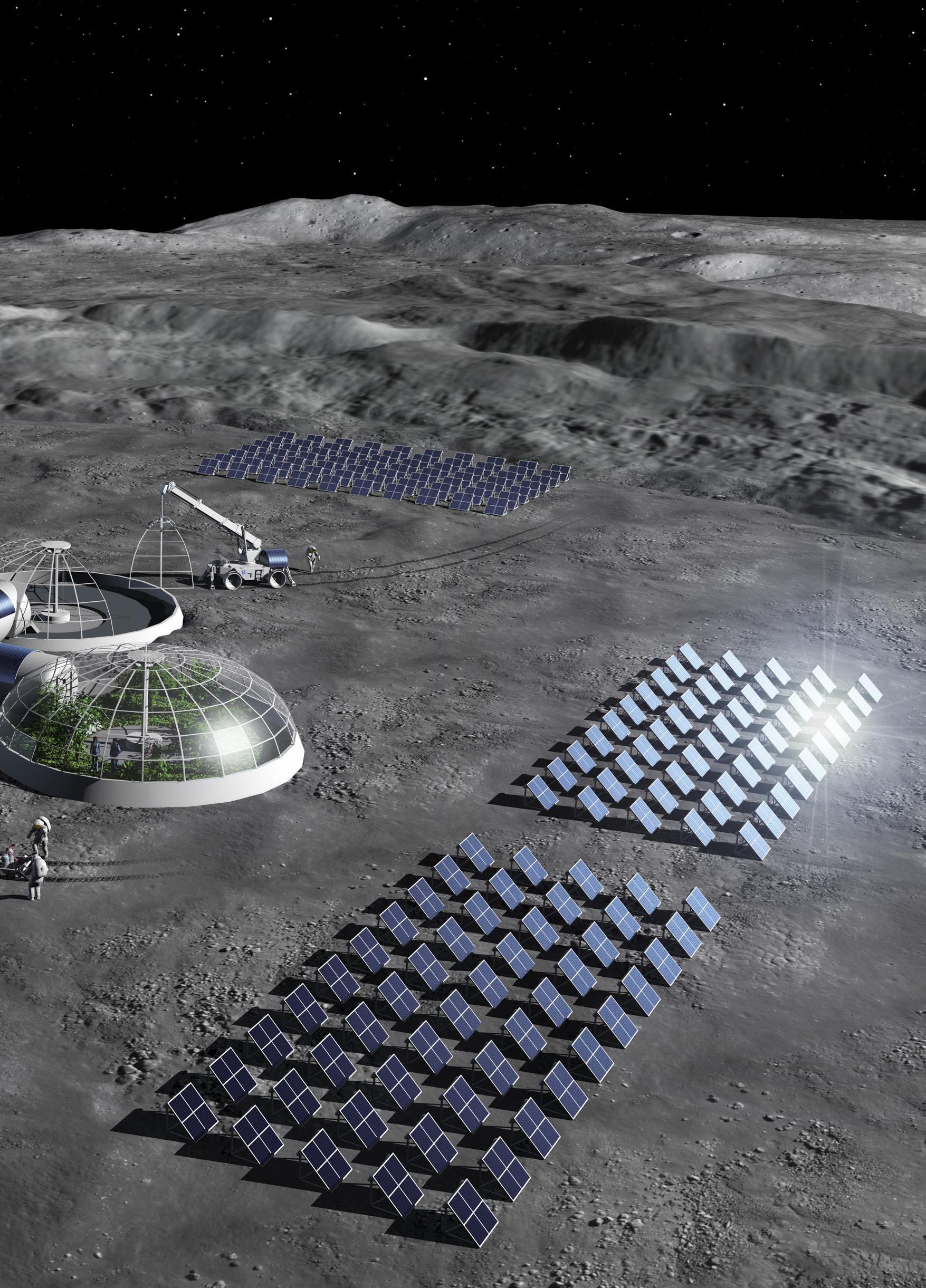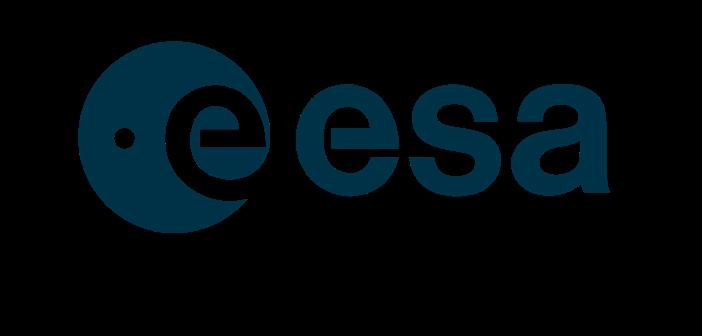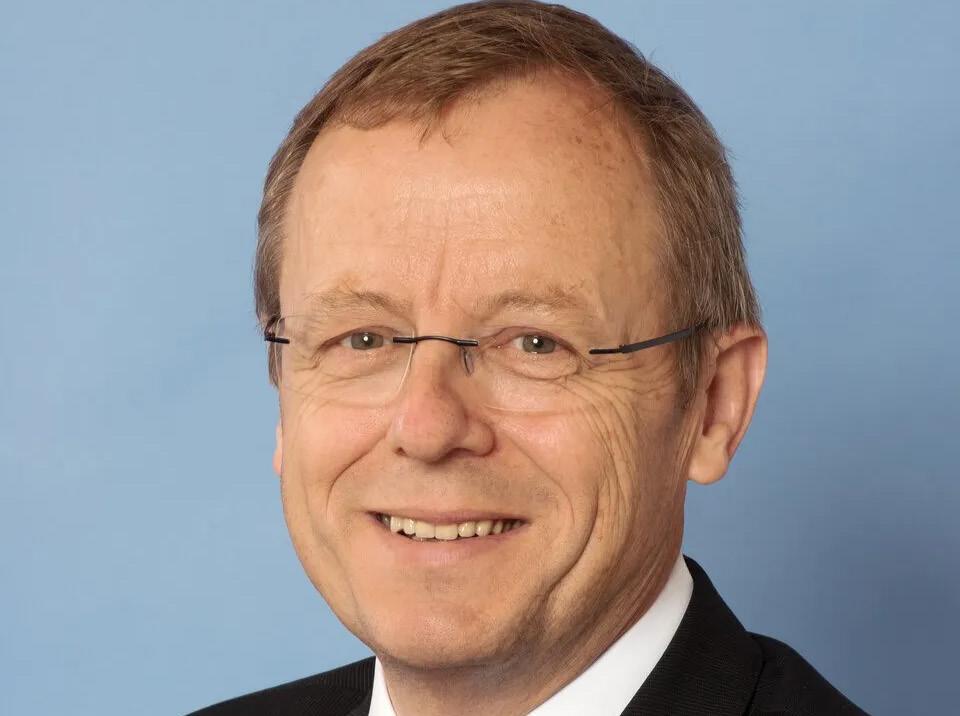
10 minute read
MOON VILLAGE - A VISION FOR GLOBAL COOPERATION AND SPACE 4.0 Professor Dr.-Ing Johannes-Dietrich Wörner - Former Director General, European Space Agency (ESA
Multi-dome lunar base being constructed, based on the 3D printing concept. Once assembled, the inflated domes are covered with a layer of 3D-printed lunar regolith by robots to help protect the occupants against space radiation and micrometeoroids. © ESA/Foster + Partners
MOON VILLAGE
Advertisement
Professor Dr.-Ing Johannes-Dietrich Wörner, Former European Space Agency (ESA) Director General
- a vision for global cooperation and Space 4.0 MOON VILLAGE

From the earliest astronomy to the space race and latterly, through space-based applications, humankind has witnessed a process of constant evolution in the exploration and use of space. Now, with the International Space Station, an unparalleled level of cooperation has been achieved which has continued largely unaffected by any crises that may be occurring on Earth: Americans, Russians, Japanese, Canadians and Europeans, all pulling together, demonstrating, day in, day out, just how important it is to invest in research and technology. The paradigm shift that has been taking place in space activities for some time now is truly comprehensive in its scope and is best encapsulated by the term ”Space 4.0“, in parallel to “Industry 4.0”. The “Moon Village“ concept seeks to transform this paradigm shift into a set of concrete actions and create an environment where both international cooperation and the commercialisation of space can thrive.
Space is bridging earthly problems. Through space people from different countries are working together as our tiny planet, the pale blue dot, deserves. The International Space Station has succeeded in taking visionary ideas and turning them into reality. Yet, at the same time, the limits of what can be achieved on the ISS are clearly visible, limits which will have to be overcome when we come to conduct future international activities in space.
Space has three main addressees: society at large, the economy, and the environment - covering the environment on the surface of the Earth, like climate change as well as in space, meaning space debris, possible asteroid impacts and solar flares. A globally competitive industry is a sound basis for advancements in different areas. And finally the impact on society ranges from information like weather forecast to the value of space being a fascinating aspect which leads to inspiration and motivation. Motivation is the most important societal aspect to develop the future.

International cooperation like the ISS is therefore of utmost significance. In this context a vision was needed which goes beyond ISS but continues and even strengthens international interaction. Looking to the past, it is obvious that humans have always been driven by curiosity: they left the caves, walked to the next valley, crossed the seas… There
Artist impression of a Moon Base concept: overview. © ESA - P. Carril

is no final destination. Available technologies are limiting factor and the next step is taken as soon as new technologies allow further steps. After the race to the Moon, people were sure that Mars is the next destination. A serious analysis of such a trip shows that the duration of a return trip, the radiation levels to which one would be exposed and the current transport capabilities are not in accordance with each other. A call “Houston we have a problem” after a couple of days of being on the journey to Mars would not allow to define a plan to be
back in less than a week. Humanity will travel to Mars and beyond if the necessary technology is available, but this needs some more research and development.

As the destination of such a vision the Moon was selected, being beyond low Earth orbit but close enough to become reality in a foreseeable period of time.
The motto was “Multi Partner Open Concept”. After some exchanges with journalists it
Artist impression of a Moon Base concept. Solar arrays for energy generation, greenhouses for food production and habitats shielded with regolith. © ESA - P. Carril
became obvious that a better wording was necessary as a narrative. The Moon Village was born.
The Moon Village concept was developed through a process of thorough analysis before being communicated across the globe. The first thing that it is vital to understand about this is that what we are describing is neither a project nor a programme. It would instead be best characterised as an idea, a concept. By Moon Village we do not mean some development planned around a cluster of houses, some shops, a pub and a community centre. Rather, the term “village“, in this context, refers to the following key notions: a village community is what emerges when a group of people join forces in one place without any concrete plans for the future and without first sorting out every detail, instead simply coming together with a view to sharing interests and capabilities. It is this principle that forms the basis for the Moon Village concept.
And to be clear, Moon Village does not entail plans to move people from Earth to the Moon for the rest of their life. In our solar system only our home planet - the Earth - provides us with all the ingredients for a nice existence. To live permanently in a “can” is no alternative. Those who talk about leaving Earth because of climate change and pollution should understand this and stop their talking because it could be used as an excuse to not take care of the environment.
Moon Village is open to any and all interested parties, private or public – “villagers” of every nationality are more than welcome. There are no stipulations as to the form their participation might take: robotic and astronaut activities are equally sought after. One might envisage not only scientific and technological activities taking place there but also activities based on exploiting resources, and even tourism. It is precisely the open nature of the concept which would allow many nationalities to go to the Moon and take part while leaving behind them on Earth any differences of opinion they may have. Not only that, but you would no longer have to worry about the need for a common docking port.
From a scientific perspective, the Moon is truly fascinating, firstly as an archive of Earth’s early history, but also because you could site a radio telescope on the far side of the Moon and stare deep into the Universe without any interference from man-made signals. While in the past the exploration of planets and moons has had to be carried out by space probes required to take with them all the necessary resources and infrastructure, this concept would allow methods to be developed and tested based on technologies such as additive manufacturing that could potentially make use of locally available resources.
Setting up a future lunar base could be made much simpler by using a 3D printer to build it from local materials. Industrial partners including renowned architects Foster + Partners joined ESA to test the feasibility of 3D printing using lunar soil. The base is first unfolded from a tubular module that can be easily transported by rocket. An inflatable dome then extends from one end of this cylinder to provide a support structure for construction. Layers of regolith are then built up over the dome by a robot operated 3D printer (right) to create a protective shell. © ESA/Foster + Partners

Since it is clear that in the future humans will take part in crewed missions to travel further into the Solar System, the Moon Village could act as the perfect springboard and testing ground with that objective in mind. In this context, also worth mentioning is NASA’s Journey to Mars plan, for example, since it too is based on taking a series of intermediate steps before humans are capable of visiting our closest neighbouring planet.
It is not about going “back to the Moon” but going “forward to the Moon” in order to clearly announce that we are not targeting another race in space, but looking for a cooperative approach. It is not about national flags and other symbols and signs of national pride. The Moon Village Concept is based on the understanding that humankind is working together in space.
To judge by the reaction from space professionals and general public alike so far, the Moon Village concept has the potential – by providing fascination, inspiration and motivation in equal measure – to awaken renewed interest in the STE(A)M subjects, science, technology, engineering and mathematics and even any other area, with benefits being felt well beyond the world of space. The aim now must be to bring the various interested parties together so as to achieve at least some degree of coordination and exploitation of potential synergies.




Artist impression of activities in a Moon Base. Power generation from solar cells, food production in greenhouses and construction using mobile 3D printer-rovers. © ESA - P. Carril Artist impression of prospection activities in a Moon Base. © ESA - P. Carril

Where are we today?
Several Moon-missions have already been performed, some are underway and others yet are planned. It is obvious that the space community is exchanging information about their various activities and more and more cooperation schemes are used. In this context the Lunar Gateway plays a central role: The Gateway is mainly brought forward by NASA. Several States have announced their interest in participating to the Gateway. ESA Member States are already provide funding within the European Exploration Envelope Programme to contribute essential hardware systems to the Gateway. The Gateway can be used as a station to remotely control rovers on the surface of the Moon or for the descend of astronauts. At this time it is important to keep the “hatches” of the Gateway open for various space actors, public and private. Another action is the joint preparation of Roscosmos and ESA for some robotic actions on the surface of the Moon.
After more than a decade of permanent advocating, the Moon Village Concept is a reality now and I am looking forward to more and more Villagers…
Professor Dr.-Ing Johannes-Dietrich Wörner, Former European Space Agency (ESA) Director General
Previously, from March 2007 to June 2015, he served as Chairman of the Executive Board of the German Aerospace Center (DLR).
Jan Wörner has been awarded numerous prizes and positions, such as the Prize of the Organisation of Friends of Technical University Darmstadt for ‘outstanding scientific performance’. He was also appointed to the Berlin Brandenburg Academy of Sciences and to the Convention for Technical Sciences (acatech) and is a representative of the Technical Sciences Section of the Leopoldina, the national academy of sciences of Germany.
Jan Wörner has received honorary doctorates from New York State University at Buffalo (USA), technical universities of Bucharest (Romania) and Mongolia, the Saint Petersburg University for Economics and Finance (Russia) and École Centrale de Lyon (France). He has received the Federal Cross of Merit (Officer’s cross, 1st class) of the Federal Republic of Germany for his continuous efforts regarding the next generation of scientists and Germany as a location for Science, Technology and Engineering. He has furthermore been awarded the honours of Knight of the French Légion d’Honneur.
Jan Wörner was Vice President of the Helmholtz Association and a member of various national and international supervisory bodies, advisory councils and committees. He was a member of the administrative boards of École Centrale Paris, École Centrale de Lyon, TU Berlin, the Instituto Superior Técnico, University of Lisbon, the Arts and Music University in Frankfurt and has been a member of several supervisory boards including Carl Schenck AG, Röhm GmbH, TÜV Rheinland AG and Bilfinger SE.
Furthermore, he was appointed to the energy expert group of the German Government. Before joining ESA as Director General, Jan Wörner was head of the German delegation to ESA from 2007 to 2015 and served as Chairman of the ESA Council from 2012 to 2014.










